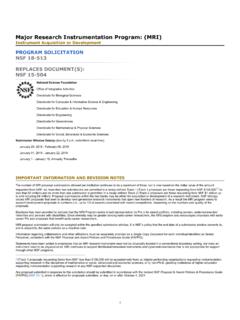Transcription of Livestock marketing in Ethiopia: A review of structure ...
1 Livestock marketing in Ethiopia: A review of structure , performance and development initiatives Socio-economics and Policy Research Working Paper 52 Ayele Solomon, Assegid Workalemahu, Jabbar Ahmed and Belachew Hurissa Livestock marketing Authority The Federal Democratic Republic of Ethiopia Box 24492 Code 1000, Addis Ababa, Ethiopia International Livestock Research Institute Box 30709, Nairobi, Kenya Working Papers Editorial Committee Mohammad A. Jabbar (Editor) Samuel E. Benin (Editor) Mohamed M. Ahmed Berhanu Gebremedhin Steven J. Staal SePR Working Papers contain results of research done by ILRI scientists, consultants and collaborators . The Working Papers are not subjected to full refereeing and are disseminated to motivate discussion and comment. It is expected that most of the Working Papers will be published in some other form. The author(s) alone is (are) responsible for the contents.
2 Table of Contents Authors affiliations Ayele Solomon, International Livestock Research Institute (ILRI), Box 5689, Addis Ababa, Ethiopia Assegid Workalemahu, ILRI, Box 5689, Addis Ababa, Ethiopia Jabbar, ILRI, Box 5689, Addis Ababa, Ethiopia Ahmed, ILRI, Box 5689, Addis Ababa, Ethiopia Belachew Hurissa, Livestock marketing Authority, The Federal Democratic Republic of Ethiopia, Box 24492 Code 1000, Addis Ababa, Ethiopia 2003 ILRI (International Livestock Research Institute) All rights reserved. Parts of this document may be reproduced without express permission for non-commercial use but with acknowledgment to ILRI. ISBN 92 9146 137 7 Correct citation: Ayele Solomon, Assegid Workalemahu, Jabbar , Ahmed and Belachew Hurissa. 2003. Livestock marketing in Ethiopia: A review of structure , performance and development initiatives. Socio-economics and Policy Research Working Paper 52.
3 ILRI (International Livestock Research Institute), Nairobi, Kenya. 35 pp. Table of Contents Acknowledgements Executive summary 1 Introduction and objectives 2 Domestic Livestock marketing and prices Market structure and price formation Evidence on market structure , performance and prices Market information and statistics Evidence from field studies 3 Livestock exports Official exports Unofficial exports 4 Policy and project initiatives to improve Livestock marketing 5 Information gaps and conclusion References Appendix A Appendix B Acknowledgements This review was conducted at the invitation and initiative of Ato Getachew Tekle- Medhin, Vice-Minister and Head of the Livestock marketing Authority, Government of the Federal Democratic Republic of Ethiopia. The authors are grateful to Lucila Lapar, Abdul Kamara and Jemberu Eshetu for useful comments on earlier drafts.
4 Executive summary The Livestock sector in Ethiopia contributes 12 and 33% of the total and agricultural Gross Domestic Product (GDP), respectively, and provides livelihood for 65% of the population. The sector also accounts for 12 15% of total export earnings, the second in order of importance. However, in recent years official export has been declining while illegal export has been increasing. The Middle Eastern countries have been a traditional export market for Ethiopian animals but increasingly stringent health and quality control regulations restricted exports to these countries in recent years. Of the total household cash income from crop and Livestock , Livestock account for 37 87% in different parts of the country, and the higher the cash income the higher is the share of Livestock , indicating that increased cash income come primarily from Livestock , particularly in the pastoral areas.
5 Therefore, the long-term impact of export ban on the local economy, especially in the pastoral areas, is likely to be severely negative on several fronts. There will be increased pressure on feed resources due to increased Livestock population, while unsold animals will depress domestic prices of animals thus reducing the income and purchasing power of Livestock owners. This will further reduce domestic trade for other commodities, creating a downward spiral in several sectors. However, current knowledge on Livestock market structure , performance and prices is poor and inadequate for designing policies and institutions to overcome perceived problems in the marketing system. Knowledge on how marketing routes and systems could contribute to the spread of diseases and the implications of these for national and international trade in Livestock is also highly inadequate to design any policy or institutional innovation to improve marketing for the benefit of the poor.
6 Further, regaining the export market will require an understanding of the market potential in the importing countries including growth in demand, sanitary and phytosanitary (SPS) and other quality requirements, rules and regulations governing the market, Ethiopia s competitiveness in the market in relation to alternative suppliers and ability of the domestic market to respond to the export market opportunities. Since the livelihood of smallholders is highly dependent on the cash income from Livestock and Livestock products, alleviating constraints to the export market and domestic trade and marketing structure , improving market information, and upgrading marketing infrastructures including health and sanitary conditions will increase the welfare of smallholder producers, urban consumers and improve the national balance of payments. This paper reviews current knowledge on market structure , performance, export and related issues, Livestock marketing development efforts and outcomes.
7 It then identifies information gaps and recommends research that may help to reduce inefficiencies in the domestic market and identify opportunities in the export market. 1 Introduction and objectives Livestock perform multiple functions in the Ethiopian economy by providing food, input for crop production and soil fertility management, raw material for industry, cash income as well as in promoting saving, fuel, social functions, and employment. Various estimates show that the Livestock sub-sector contributes 12 16% of the total and 30 35% of agricultural GDP, respectively (MEDaC 1998; AAPBMDA 1999). The sector s contribution to national output is underestimated because traction power and manure for fertiliser are not valued. Contributing 12 15% of total export earnings, the sub-sector is the second major source of foreign currency through export of live animals, hides and skins (MEDaC 1998; FAO 1999).
8 The sector also employs about one-third of the country s rural population (EARO 2000). Therefore, Livestock can serve as a vehicle for improving food security and better livelihood, and contribute significantly to agricultural and rural development. Ethiopia has the largest Livestock population and the highest draft animal population in the continent. There are approximately 35 million cattle, 39 million sheep and goats, million equine, 1 million camels, and million chickens in the country1 (FAO 1999). Generally, sheep are the predominant Livestock in areas over 3000 metre above sea level (masl) and at altitude over 3500 masl farmers keep only sheep. Cattle are common below 3500 masl. Livestock are most common in the 1500 to 2800 masl range. Cattle, camels and goats are prominent domestic animals in the lowlands below 1500 masl. Chickens are ubiquitous in all production systems.
9 1. The Ethiopian Central Statistical Authority (CSA) estimated million cattle, million sheep, and million goats only in the highlands (1,500 metre above sea level, masl) and mixed farming systems, home and 75 80% of cattle and sheep and 30% of goat population in the country (CSA 1999a). Between 1974 and 1998, human population increased by 78% while cattle population increased by 31%, and small ruminant population decreased by (Figure 1). Annual growth rate for human population was while that for cattle and small ruminants was and , respectively. During the same period meat, milk and skins and hides production have increased by , and , respectively (FAO 1999). Despite the large number of Livestock , there has been a decline in national and per capita production of Livestock and Livestock products, export earnings from Livestock , and per capita consumption of food from Livestock origin since 1974, in comparison to other African countries (Assegid 2000).
10 Source: Assegid (2000). Figure 1. Human and Livestock population trends, 1974 98. Among exports of Livestock products, skins and hides have the largest share of exports followed by live animals (MEDaC 1998; FAO 1999). In recent years, exports of live animals to the Middle Eastern countries, the traditional outlet for Ethiopian animals, have substantially decreased since these countries have imposed ban on imports of live animals from the Horn of Africa due to prevalence of certain diseases such as Rift Valley fever. Although the ban was triggered by the outbreak of the disease, most likely the ban has been also prompted by a number of other factors, change in consumer preferences and greater demand for high quality products with adequate guarantees of food safety while supply conditions in Ethiopia remained virtually unchanged to meet the rapidly changing market conditions in the importing countries.















